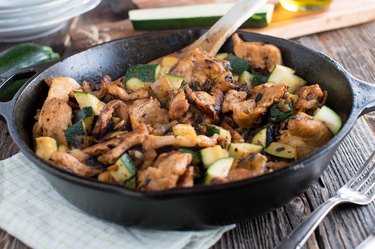
Skillet pans have been essential pieces of cookware for thousands of years. They can be used for frying, sauteing and, in the case of cast-iron skillet pans, baking foods. Today's skillet pans come in a variety of sizes and metals, but their basic form and function has remained virtually untouched.
Features of a frying pan
Video of the Day
A skillet, or frying pan, is generally 10 or 12 inches in diameter. They are round and have slightly sloped sides rather than straight sides so food can be easily removed from the pan. They have a flat bottom that lies flush with the stovetop and provides a generous surface area for cooking on whether you are using the skillet as a shallow frying pan or a saute pan.
Video of the Day
Types of skillet pans
Many people choose their cookware based on thefir cooking frequency, economic means and how serious they are about the end result. Here are four of the more common types you'll see on the market.
- Cast Iron: The workhorse of the kitchen, cast iron is lauded for its long-lasting durability. Some cast iron pans have been handed down through generations of family cooks and still function as if they were brand new. The success of cast iron as a cooking surface comes from its seasoning. Over time, cast iron naturally provides a non-stick surface as oils bake into the pan, providing a smooth and ready surface. This type of pan also has a wider range of uses, since they can be used in high-temperature conditions including in the oven or even over an open flame. They also get points for being quite inexpensive and a good value.
- Non-stick: These more modern skillets have been popular in recent years. The metal surface of the pan is has a non-stick coating so as to allow foods to come off the pan easily: this makes cleaning them much less of a hassle. One drawback to nonstick pans is that the coating tends to wear off over the years, requiring a replacement product.
- Stainless Steel: A good and inexpensive choice, stainless steel holds up fairly well over time, especially if the user is careful in his or her endeavors in the kitchen. A stainless steel skillet is at a disadvantage in that food tends to burn and stick more easily on this surface under high heat.
- Copper: A favorite with professional chefs, copper gets points for having the most evenly distributed heat conduction out of any of the other metals. However, the high quality of this metal is often quite expensive for many home cooks.
Functions of skillet pans
A good skillet can be used for any number of cooking techniques in the kitchen. They are most commonly used for frying eggs or making an omelet or pancakes. A good skillet will have a couple of inches of depth to them so you can use them for deep frying as well. However, since skillets don't have vertical sides, you need to take care the oil doesn't spill over the slanted sides.
They are also used for any type of saute work, stir-frying or pan-searing steaks and fish. And, if you're using an oven-safe skillet, such as a cast iron skillet, you can use them for baking cakes, quick breads and casseroles.
The price range of frying pans
Modern cast iron skillets can go for under $30.00; a high-end aluminum copper core pan can go for nearly $200. Price can be determined by the materials used, branding and size. Many good working skillet sets can be bought for under $100.
The significance of skillet pans
Its historic utility aside, it would be a rare thing to find a kitchen or cooking area without a single skillet, and many families incorporate two or three types of skillets, often made of different materials, that serve a full range of functions.